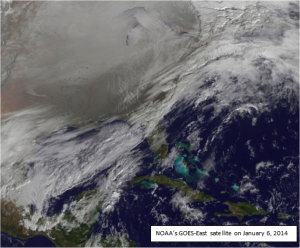The Polar Vortex – A Visit from the North Pole
Large snow storms and record lows are not usually what come to mind when discussing climate change, but this year we’ve had to rethink what climate change means.
 By now just about anyone who watches the news has heard of the Polar Vortex. A year ago few people knew about this jet stream of cold air that circulates around the North Pole because it was located near sparsely populated areas near the North Pole and parts of Canada. This year the Polar Vortex felt like taking a vacation–a lot of vacations.
By now just about anyone who watches the news has heard of the Polar Vortex. A year ago few people knew about this jet stream of cold air that circulates around the North Pole because it was located near sparsely populated areas near the North Pole and parts of Canada. This year the Polar Vortex felt like taking a vacation–a lot of vacations.
The Polar Vortex frequently dipped down into the U.S. this winter. This year the vortex lost some of its stamina, and that’s when it began making visits to the U.S. Wind speeds within the vortex are usually moving as fast as 100 mph, but this year the winds slowed down making it less stable.
So, how is the Polar Vortex related to climate change? The answer requires some explanation. You’ve probably heard that the Arctic is rapidly warming–in fact, twice as fast as the rest of the world. As sea ice melts, the sun’s rays are no longer reflected but are instead absorbed by the dark ocean water. The result is a gradually decreasing temperate difference between Arctic air and air at lower latitudes.
The decrease in temperature differences is thought to be the reason for the Polar Vortex shifting so far south this year. The air within the Polar Vortex is a polar high pressure cell. As the air within the polar cell begins to warm from climate change, the system becomes less high pressure. Scientists believe that changes occurring in the polar high pressure cell weakened the Polar Vortex, which is a low pressure system that moves around the cell. It was weakened enough that it tilted down into North America.
The connections between the Polar Vortex and climate change will continue to be debated and discussed, especially by those still thawing out from this chilly winter-weather. One thing we can all agree on—we’re ready for Spring!








